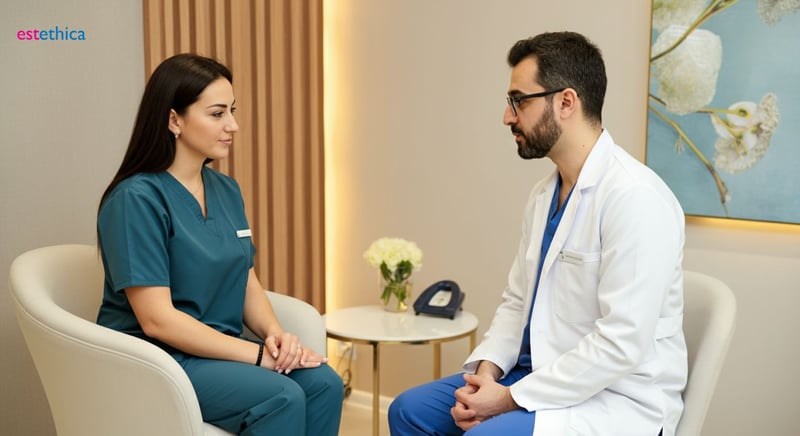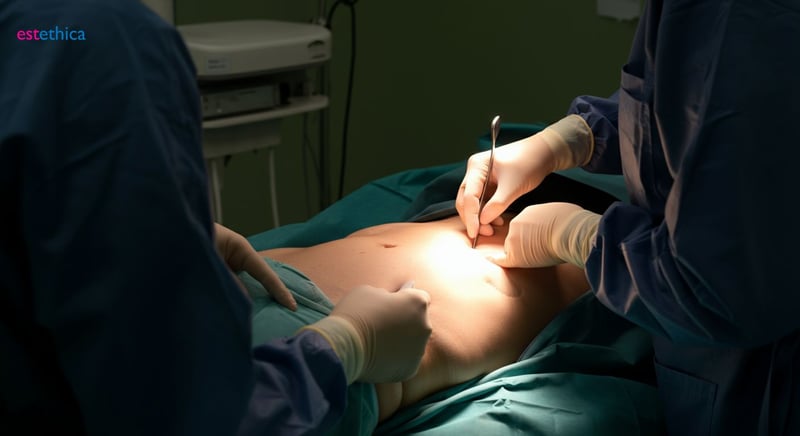Tummy Tuck: Reshape Your Body & Confidence!
Reshape your abdomen and confidence with a tummy tuck. Explore your candidacy and start a transformative journey today!
Tummy tucks have become a highly sought-after procedure for those looking to regain their body’s tone and confidence. But what exactly does this procedure entail? From understanding the procedure to choosing the right tummy tuck clinic, this guide covers everything you need to know about embracing a transformative journey through abdominoplasty.
What is a Tummy Tuck & Is It Right for You?
Understanding the Tummy Tuck Procedure
A tummy tuck, technically known as abdominoplasty, is a cosmetic procedure aimed at improving the appearance of the abdomen. It involves the removal of excess skin and fat and tightening of abdominal muscles, resulting in a smoother and firmer abdominal profile. Ideal candidates for a tummy tuck are individuals with loose or sagging skin around the stomach area due to major weight loss, aging, or post-pregnancy changes. Consulting with cosmetic surgery experts can further clarify the procedure's scope.
Before undergoing a tummy tuck, it's essential to assess your health status and expectations. Consulting with a board-certified cosmetic surgeon can provide personalized insights into whether this procedure aligns with your aesthetic goals and lifestyle needs. This process ensures that your expectations are realistic, and you're fully informed about the potential outcomes and recovery process, helping you make an informed decision about pursuing Tummy Tuck Secrets: Reveal a Flatter, Firmer You.
Key Considerations for Tummy Tuck Candidacy
- Health Assessment: Comprehensive evaluation to ensure suitability for surgery.
- Realistic Expectations: Understanding the achievable results and limitations.
- Lifestyle Integration: Planning for the recovery period and necessary adjustments.
For instance, individuals considering a tummy tuck post bariatric surgery often experience significant improvements in their abdominal contour, addressing concerns like excess skin removal and improving body symmetry. The national average for individuals undergoing body contouring procedures like belt lipectomy after massive weight loss has increased by nearly 15% in the last five years, underscoring the growing demand for these transformative surgeries.

Mastering Tummy Tuck Recovery: Timeline and Tips
Navigating the Initial Recovery Phase After a Tummy Tuck
The initial phase of recovery following a tummy tuck is critical for optimal healing. Generally, this period lasts about one to two weeks, where the focus is on managing pain, reducing swelling, and preventing complications. Patients are advised to rest and limit their movements to avoid stressing the surgical area. During this time, it’s essential to follow the surgeon's specific instructions regarding medication, wound care, and posture.
Proper wound care is paramount during the first few weeks post-surgery. Patients should keep the incision site clean and dry, changing dressings as directed by their surgeon. Signs of infection, such as increased redness, swelling, or discharge, should be reported immediately to the medical team. Gentle walking is often encouraged to promote circulation and prevent blood clots, but strenuous activities must be avoided. A study showed that patients who followed a strict post-operative care plan experienced approximately 30% fewer complications during the initial recovery phase.
Essential Steps for a Smooth Tummy Tuck Recovery
- Follow Surgeon's Instructions: Adhere strictly to all post-operative guidelines for medication, wound care, and activity restrictions.
- Maintain a Healthy Diet: Consume nutritious foods to support healing and prevent constipation, which can strain the abdominal area.
- Avoid Strenuous Activities: Refrain from lifting heavy objects or engaging in intense exercises for at least six weeks.

Beyond the 'After' Photos: Understanding Tummy Tuck Results
Realistic Expectations for Your Tummy Tuck Transformation
The allure of before and after photos can set high expectations for a tummy tuck. While significant improvements are common, understanding the nuances of what a tummy tuck can realistically achieve is crucial. The procedure typically creates a firmer, flatter abdomen by removing excess skin and fat, and tightening weakened muscles. However, factors like skin elasticity, body type, and adherence to post-operative care can influence the final outcome.
It is important to acknowledge that a tummy tuck, also known as abdominoplasty, aims to enhance rather than perfect. Consulting with a qualified cosmetic surgeon helps tailor the surgery to your specific needs and ensures you have a clear understanding of what can be achieved. Discussing all aspects, including potential scarring and recovery, will help you approach the surgery with informed optimism.
Factors Influencing Tummy Tuck Outcomes
- Skin Elasticity: The degree of skin laxity impacts the extent of contour improvement.
- Muscle Tone: Tightening the abdominal muscles contributes to a flatter, more toned appearance.
- Lifestyle Habits: Maintaining a stable weight and healthy lifestyle post-surgery helps preserve results longer.
For example, a comprehensive abdominoplasty is often paired with diastasis recti repair to address muscle separation from pregnancy, contributing to improved core strength and abdominal aesthetics. Recent advancements in surgical techniques, such as combining a tummy tuck with liposuction, offer enhanced contouring and improved results for patients seeking significant abdominal reshaping. Studies indicate that patients who combine Tummy Tuck Secrets: Reveal a Flatter, Firmer You with body contouring procedures demonstrates an 80% high degree of satisfaction with their enhanced body profile.

Tummy Tuck vs. Abdominoplasty: Know the Difference!
Decoding the Terminology: Tummy Tuck and Abdominoplasty
While the terms "tummy tuck" and "abdominoplasty" are often used interchangeably, it's essential to recognize them as different ways to describe the same cosmetic surgery. This procedure primarily aims to flatten the abdomen by eliminating excess skin and fat, while also tightening abdominal muscles. A full abdominoplasty can significantly enhance the abdominal profile. Understanding that both terms refer to the same core procedure helps clarify potential confusion for those considering Tummy Tuck Secrets: Reveal a Flatter, Firmer You.
However, the scope of each procedure can vary depending on individual needs. A mini tummy tuck, for example, typically addresses only the area below the navel, making it suitable for individuals with less extensive skin laxity. Conversely, an extended tummy tuck might be recommended for those who have significant excess skin after massive weight loss or multiple pregnancies, often including flank or hip contouring. Distinguishing between these variations ensures patients approach the surgical consultation with informed expectations, aligning their choice with specific aesthetic goals such as achieving tummy tuck before and after transformations.
Exploring Variations in Abdominoplasty Techniques
- Mini Tummy Tuck: Targets only the lower abdomen, ideal for minimal skin laxity.
- Full Tummy Tuck: Addresses the entire abdominal area, including muscle tightening.
- Extended Tummy Tuck: Extends to the flanks or hips for more comprehensive contouring.
For example, a patient seeking a tummy tuck near me might find that several clinics offer specialized consultations to determine the most appropriate surgical approach based on their unique anatomy and desired outcomes. In some cases, patients may also explore non-surgical tummy tuck alternatives, although these typically offer less dramatic results compared to surgical abdominoplasty. A comprehensive consultation can help patients understand these distinctions and make informed decisions about their body contouring options.
Matching Procedure to Patient Needs: A Personalized Approach
- Assessing Individual Goals: Understanding what the patient wants to achieve is key.
- Evaluating Body Structure: Assessing abdominal muscle tone and skin laxity is essential.
- Considering Lifestyle Factors: Discussing activity levels and long-term expectations to ensure procedure alignment.
Recent studies indicate that patient satisfaction with abdominoplasty is significantly higher when the surgical plan is tailored to their specific anatomical needs and aesthetic goals. For instance, individuals with diastasis recti are likely to benefit from a tummy tuck that includes muscle repair, while those with significant excess skin post weight loss may require an extended procedure or belt lipectomy. Understanding these nuances and tailoring the approach allows surgeons to deliver results that align well with the unique needs of each patient. For example, an abdominoplasty can be performed on men with excess skin, also known as tummy tuck male.
Advanced Abdominoplasty Techniques for Enhanced Body Contouring Results
Personalized Tummy Tuck Approaches Ensuring Patient Satisfaction
Frequently Asked Questions
What is the key difference between a tummy tuck and abdominoplasty?
Who is an ideal candidate for tummy tuck candidacy, and what are the key considerations?
What essential steps can ensure a smoother tummy tuck recovery?
Beyond just "after" photos, what factors impact the results of a tummy tuck?
Achieve healthy beauty with estethica's award-winning aesthetic services and expert care.
📞 Book Your Free Consultation!